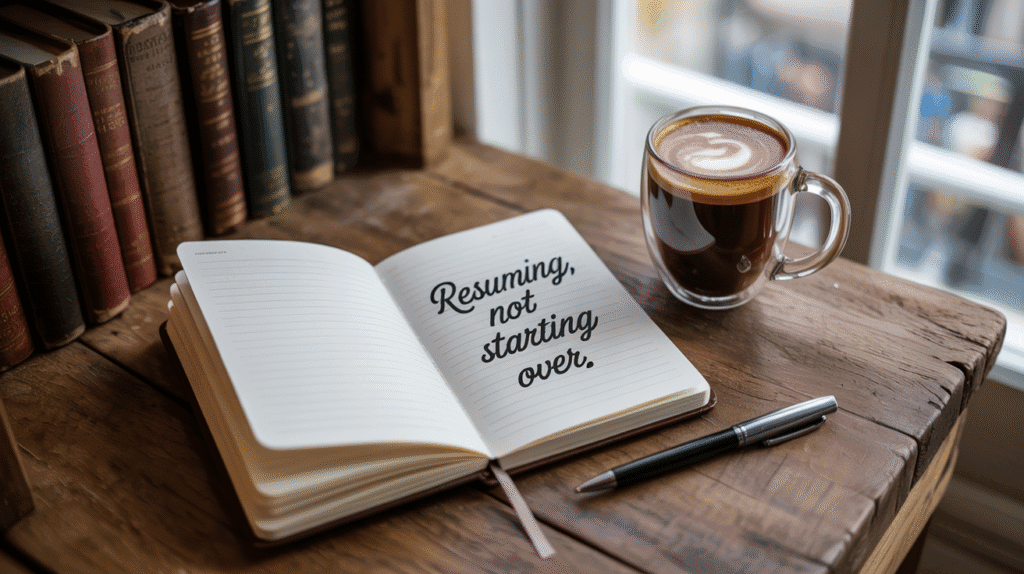
You missed a day. Then a week. Suddenly, the habit that once felt solid is just… gone. The old guilt creeps in: “I blew it again.” And the voice in your head says, “Looks like we’re starting over.”
But here’s the truth: you’re not starting from scratch—you’re starting from experience.
Falling off track is not failure. It’s part of the rhythm of real life. The goal of habit-building isn’t to never break the chain—it’s to know how to return when you do.
What you need isn’t a reboot. You need a re-entry. A way to pick up where you left off without shame, overwhelm, or the pressure to “make up” for lost time.
In this article, you’ll learn how to restart habits with self-respect, flexibility, and clarity—so your comeback feels like momentum, not punishment.
One of the most damaging ideas in habit-building is the belief that if you break the streak, you have to start from zero. It creates a mental reset that erases all previous progress—as if everything you did before suddenly doesn’t count.
But here’s the truth: you’re not starting over—you’re resuming.
Every habit you’ve built—even the ones that faded—left something behind:
You don’t need to rebuild the whole structure. You just need to plug back in.
Think of it like reopening a paused book. You don’t start on page one. You flip back a few pages, find your place, and keep going. The same applies to habits.
The energy you spent before wasn’t wasted—it was groundwork. And now you get to continue with more wisdom, more self-awareness, and a better understanding of what helps you stay connected.
Resuming shifts the story—from failure to return. From guilt to growth.

When we fall off track, the natural instinct is to blame ourselves. “I got lazy.” “I always do this.” But guilt is a terrible motivator—and an even worse teacher.
Instead of shaming yourself, try curiosity. Not “What’s wrong with me?” but:
“What got in the way—and what could help next time?”
This isn’t about finding flaws. It’s about finding patterns.
Here are a few gentle prompts to guide your reflection:
This kind of reflection turns your “failure” into feedback. It shows you how to adapt instead of abandon.
And sometimes, the honest answer is: life got hard. That’s okay too. You didn’t drop the habit because you’re undisciplined—you dropped it because you’re human. And now, you have the insight to adjust and return wiser than before.
Reflection isn’t about blame—it’s about building a better path forward.
After a break, it’s tempting to jump back in with full force—to “make up for lost time” or prove to yourself that you’re still committed. But that rush to intensity often backfires. It overwhelms your system, reignites pressure, and leads to another burnout cycle.
Instead, give yourself permission to re-enter slowly.
Think of it as a 3- to 7-day reactivation period—not to rebuild everything, but to reconnect lightly and consistently. Start with the minimum version of your habit. Focus on touching the habit daily, even if it’s brief or incomplete.
If your habit was exercise, walk for five minutes. If it was writing, open your journal and write a sentence. If it was meditation, breathe consciously for one minute.
Create a gentle rhythm, not a grand return. Make it feel doable—even on a low-energy day. Keep expectations quiet, flexible, and kind. Let the act of showing up be the win.
And remember: the goal is reconnection, not performance. Your habit doesn’t need to be perfect again. It just needs to feel possible.
Let the re-entry be a soft landing—not a pressure test.

Many habits break not because you stopped caring—but because the rules around them became too heavy to hold. You built a routine so specific, so idealized, that it collapsed the moment life shifted.
To keep a habit alive long-term, you need fewer conditions and more flexibility.
Instead of requiring perfect time slots, tools, or performance, give yourself permission to adapt. Ask: What’s the simplest version of this that I can still do when life gets messy?
Let your habit be portable, adjustable, and forgiving. It’s better to do five minutes imperfectly than to skip entirely because the environment or energy wasn’t “right.”
This shift changes everything. You no longer need to start over—you just keep going, in whatever form you can manage.
And when you protect the habit—not with force, but with flexibility—it starts to protect you back. It becomes a source of grounding instead of stress. A quiet reminder that showing up is enough.
Habits don’t need to be rigid to be real. They need to be resilient.
Falling off track doesn’t mean you failed. It means you’re human. Life moved, energy shifted, priorities changed—and that’s not a reason to start over. It’s a reason to return with more wisdom and less pressure.
You don’t need to rebuild your habits from the ground up. You just need to remember: the ground is still there. The foundation is still solid. The effort you’ve made before still matters.
Resuming is a skill. A mindset. A choice to keep the thread alive, even when the pattern gets interrupted.
So come back slowly. Come back kindly. Come back with smaller steps and fewer rules. And trust that showing up—imperfectly, irregularly, but consistently—is always enough.
Progress isn’t about never falling. It’s about how gently you’re willing to rise again.